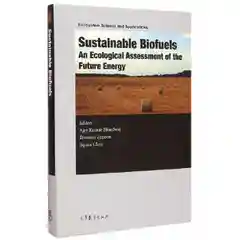-
已选 件

- 已售件
-
服务
- √7天无理由退货(拆封后不支持)
- √假一赔三
- √消费者保障服务



商品详情
-
ISBN编号
9787040411218
-
作者
[印] 巴德瓦杰,[意] 泽诺内,[美] 陈吉泉 主编 著
-
出版社名称
高等教育出版社
-
出版时间
2015-03-01
-
开本
16开
- 纸张
- 包装
-
是否是套装
否
-
ISBN编号
9787040411218
-
作者
[印] 巴德瓦杰,[意] 泽诺内,[美] 陈吉泉 主编 著
-
出版社名称
高等教育出版社
-
出版时间
2015-03-01
-
开本
16开
- 纸张
- 包装
-
是否是套装
否
- 查看全部

【编辑推荐】
随着石油资源日益枯竭,生物燃料越来越受到青睐。本书详细描述了第二代和第三代生物燃料生产系统的生态影响,涵盖了多种易于被采用的生物燃料种植的理论基础,并说明了实现利益所需要的生态条件。巴德瓦杰、泽诺内、陈吉泉编写的《可持续生物能源(英文版生态系统科学与应用)(精)》分为几大部分,分别介绍了不同的生物燃料作物模型、它们的生物地球化学的影响、边际土地利用、生物修复的前景、可持续性和全球潜力评估的生命周期分析原理。这些都是生物燃料行业和科学界*关心的关于可持续发展、环境和经济的重要方面。-第二代和第三代纤维素和传统的生物能源原料的生态意义-由来自超过10个国家的该领域的权威专家撰写-世界不同地区多种生物燃料原料的工作模式。
【内容简介】
随着石油资源日益枯竭,生物燃料越来越受到青 睐。本书详细描述了第二代和第三代生物燃料生产系 统的生态影响,涵盖了多种易于被采用的生物燃料种 植的理论基础,并说明了实现利益所需要的生态条件 。巴德瓦杰、泽诺内、陈吉泉编写的《可持续生物能 源(英文版生态系统科学与应用)(精)》分为几大部分 ,分别介绍了不同的生物燃料作物模型、它们的生物 地球化学的影响、边际土地利用、生物修复的前景、 可持续性和全球潜力评估的生命周期分析原理。这些 都是生物燃料行业和科学界关心的关于可持续发展 、环境和经济的重要方面。
【目录】
Part I Introduction
1 The Sustainable Biofuels Paradigm
1.1 Biofuels: Opportunities and Challenges
1.1.1 From Fossil Fuels to 1st Generation Biofuels
1.1.2 A Case for 2nd and 3rd Generation Biofuels
1.2 The Sustainability Paradigm and Biofuels
References
Part II Biofuel Crop Models
2 Switchgrass for Bioenergy: Agro-ecological Sustainability
2.1 Introduction.
2.1.1 Switchgrass--A Short History of and the Case for
Its Use as a Biofuel Feedstock
2.2 Energetic and Economic Considerations in Sustainability
2.2.1 Energy In: Energy Out (Is Making Biofuel from
Switchgrass Energetically Feasible?~
2.2.2 Economic Tipping Points (Is Making Biofuel from
Switchgrass Economically Feasible?)
2.2.3 Using Value-added Products to Shift the Tipping Point
2.2.4 Farmer and Factory Relationships: Getting the Ball Rolling
2.2.5 Ethical/Social/Fairness Dimensions of the Sustainability ‘
2.3 Ecological/Environmental/Resource Considerations of
the Sustainability
2.3.1 Sustaining the Soil Resource‘
2.3.2 Sustaining the Air Resource: GHGs and Climate
2.3.3 Sustaining the Water Resource: Depletion and Pollution Concerns~
2.3.4 Sustaining Biological Resources: Biopersity
2.4 Managing Switchgrass for Bioenergy and Sustainability
2.4.1 Description, Adaptations, and Selection
2.4.2 Establishment
2.4.3 Fertility in an Agroecological and Sustainability Context
2.4.4 Mechanization, Storage, and Hauling
2.4.5 Demands of a Bioenergy Industry.
2.5 Conclusions
References
3 Sugarcane as an Alternative Source of
Sustainable Energy
3.1 Introduction
3.2 Energy Expenses in Sugarcane Production
3.3 Nutrient and Fertilizer Expenditures of Sugarcane
3.4 Sugarcane Bagasse: A Sustainable Energy Resource
3.4.1 Electricity Generation from Bagasse
3.4.2 Reduction in Greenhouse Gas (GHG) Emissions
3.4.3 Bagasse-based Byproducts and Future Energy Assessment
3.5 Sugarcane Trash: A Potential Biomass for Sustainable Energy
3.6 Sugarcane Biomass for Biofuel Production
3.6.1 Chemical Composition of Sugarcane Biomass
3.6.2 Conversion of Sugarcane Biomass into Ethanol
3.6.3 Pretreatment of Sugarcane Biomass
3.6.4 Enzymatic Hydrolysis/Saccharification of the Cellulosic Fraction
3.6.5 Detoxification of Cellulosic and Hemicellulosic Hydrolysates
3.6.6 Fermentation of Sugars from Sugarcane Biomass into Ethanol
3.6.7 Pyrolysis of Sugarcane Biomass
3.7 Conclusions
References
4 Jatropha (Jatropha curcas L.) as a New Biofuel Feedstock for
Semi-arid and Arid Regions and Its Agro-ecological
Sustainability Issues
4.1 Introduction
4.2 Systematics and Global Distribution.
4.3 Vegetative Growth and Sexual Reproduction
4.4 Optimal and Sub-optimal Climate and Growth Conditions
4.5 Propagation
4.6 Uses and Abuses of JCL
4.6.1 Traditional Non-fuel Uses
4.6.2 Feedstock for Biofuels
4.6.3 Utilization of JCL byproducts
4.7 JCL as a Sustainable Alternative to Fossil Fuels
4.7.1 Environmental Impacts
4.7.2 Socioeconomic Impacts
4.8 Significance of Irrigation and Fertilization for JCL Cultivation
4.8.1 Effects of Irrigation on Pot-grown JCL Plants
4.8.2 Effects of Irrigation on Field-grown JCL Plants
4.8.3 Effects of Fertilization on JCL Plants
4.9 Conclusions
References
5 Environmental Aspects of Willow Cultivation for
Bioenergy
5.1 Introduction
5.2 Willow Plantations
5.3 Carbon Sequestration and Greenhouse Gas Fluxes
5.3.1 Estimates of Growth and Carbon Sequestration
5.3.2 Eddy Flux Measurements
5.3.3 Closing the Carbon Budget
5.3.4 The Fertilization Effect
5.3.5 What Are the Limits?
5.3.6 Substitution Efficiency and Climate Effect
5.4 Conclusions
References
Part III Biofuels and Biogeochemical Impacts
6 Short Rotation Forestry for Energy Production in Italy:
Environmental Aspects and New Perspectives of
Use in Biofuel Industry
6.1 Introduction
6.2 Ecological Services Provided by SRF
6.2.1 Buffer Strips and Ecological Corridors.
6.2.2 Fertirrigation: Disposal of Livestock, Urban and
Industrial Wastewaters
6.2.3 Soil Erosion Control
6.2.4 CO2 Uptake and Carbon Sequestration
6.3 Biofuel Production and SRF
6.4 Conclusions
References
7 Populus and Salix Grown in a Short-rotation Coppice for
Bioenergy: Ecophysiology, Aboveground Productivity, and
Stand-level Water Use Efficiency
7.1 Introduction
7.2 Water Use of SRC
7.3 Water Use Efficiency of SRC
7.4 WUE and Related Ecophysiological Variables Literature Surveys
7.5 Case Study: Populus in the Bohemian-Moravian Highlands
7.5.1 Introduction
7.5.2 Site and Stand Description
7.5.3 Methods
7.5.4 Results and Discussion
7.6 Conclusions
References
Part IV Biofuels and Natural Resource Management
8 Afforestation of Salt-affected Marginal Lands with
Indigenous Tree Species for Sustainable Biomass and
Bioenergy Production
8.1 Introduction
8.2 Origin and Distribution of Salt-affected Soils in India
8.3 Properties of Salt-affected Soils
8.4 Natural Vegetation on Salt-affected Soils
8.5 Management Practices for Afforestation on Salt-affected Soils
8.5.1 Selection of Tree Species
8.5.2 Pre-planting Management Strategies
8.5.3 Planting Techniques
8.5.4 Post-planting Management Strategies
8.6 Biomass Production
8.6.1 Saline Soils
8.6.2 Sodic Soils
8.7 Bioenergy Production
8.8 Soil Amelioration
8.9 Conclusions
References
9 Bioenergy and Prospects for Phytoremediation
9.1 Introduction
9.2 Bioenergy Systems for Soil Phytoremediation
9.2.1 Phytoextraction of Heavy Metals
9.2.2 SRCs and Rhizodegradation of Organic Pollution
9.3 Bioenergy Systems for Water Phytoremediation
9.3.1 Phytoremediation Systems with Municipal Wastewater
9.3.2 Phytoremediation Systems with Landfill Leachate
References
Part V Life Cycle Assessment Principles
10 Eight Principles of Uncertainty for Life Cycle Assessment of
Biofuel Systems
10.1 Introduction: Regulatory LCA
10.2 Eight Principles of Uncertainty for LCA of Biofuel Systems
10.3 Principle 1: Biofuel Production Is a Complex System of Systems
10.4 Principle 2: Standardized LCA Methods for Biofuels Do Not Exist
10.5 Principle 3: Empirical Data Are Scarce for Most Aspects of Biofuels,
10.6 Principle 4: Local Biofuel LCAs Reduce Uncertainty and Errors
10.7 Principle 5: Sensitive Parameters Cause Order of
Magnitude Changes
10.7.1 Biorefinery Natural Gas Efficiency-
10.7.2 Agricultural N20 Emissions
10.7.3 Soil Organic Carbon Dynamics and CO2 Emissions,
10.7.4 Setting an Uncertainty Standard for Biofuel LCA
10.8 Principle 6: Indirect Emissions Are Numerous and
Highly Uncertain
10.8.1 Indirect Land Use Change
10.8.2 Multiple Indirect Effects and Global Economic Forecasting
10.9 Principle 7: Transparency Is Essential for Regulatory LCA
10.10 Principle 8: Fossil Fuel Reference Systems Are Diverse and
Uncertain
i10.11 Conclusions
References
11 Energy and GHG Emission Assessments of Biodiesel
Production in Mato Grosso, Brazil
11.1 Introduction
11.2 Study Area
11.3 Methods
11.3.1 Crop Selection
11.3.2 Identification of the Area Suitable for Cultivation
11.3.3 Settings and Constraints Specific for the Case Study
11.3.4 Problem Formulation
11.3.5 Other Impacts
11.4 Results
11.5 Discussion
11.6 Conclusions.
References
Part VI Global Potential Assessments
12 Biomass Potential of Switchgrass and Miscanthus on the
USA‘s Marginal Lands
12.1 Introduction
12.2 Methods
12.2.1 Identification of the USA‘s Marginal Lands
12.2.2 Processing Land Cover Data
12.2.3 NCCPI
12.2.4 Determination of Marginal Lands
12.2.5 Development of Empirical Models
12.2.6 Sample Data
12.2.7 Regional Model Simulations
12.2.8 Data Selection
12.2.9 Model Development and Validation.
12.3 Results and Discussion
12.3.1 USA Marginal Lands
12.3.2 Model Developments and Validations
12.3.3 Biomass Estimates of Switchgrass and Miscanthus
12.3.4 Comparison of Switchgrass and Miscanthus.
12.3.5 Limitations and Future Study
12.4 Conclusions
References
13 Global Agro-ecological Challenges in Commercial Biodiesel
Production from Jatropha curcas: Seed Productivity to
Disease Incidence
13.1 Introduction
13.2 Standardization of Agro-technology -
13.2.1 Propagation Techniques
13.2.2 Planting Material
13.2.3 Nursery Managemenl
13.2.4 Field Planting
13.3 Global Seed Productivity
13.4 Techno-commercial Economics
13.5 Scope for Improvements.
13.6 Disease Incidence
13.7 Soil Amelioration
13.8 Conclusions
References
Subject Index-













